Don't wanna be here? Send us removal request.
Text
Scientists tell us that the family dog shuffling its legs while asleep on the floor really is dreaming. And when a bird silently nods off on its perch, it may also dream as its singing muscles twitch. Could it be rehearsing in its sleep?
A substantial proportion of bird species are songbirds with specific brain regions dedicated to learning songs, according to University of Buenos Aires physicist Gabriel B. Mindlin. His research examines connections between birds’ dreams and song production—particularly in Zebra Finches, which often learn new sounds and songs, and in Great Kiskadees, which possess a limited, instinctive song-learning capacity.
Scientists had previously observed sleeping birds making movements that resembled lip-syncing. In earlier work, Mindlin and his colleagues implanted electrodes in two Zebra Finches; for a recent study in Chaos, they did the same for two Great Kiskadees. This let them record and compare neuron and muscle activity in the sleeping birds.
When awake, Zebra Finches sing a well-regulated line of staccato notes. But their sleeping song movements are fragmented, disjointed and sporadic—“rather like a dream,” Mindlin says. A dozing finch seems to silently practice a few “notes” and then add another, producing a pattern of muscle activity that reminds Mindlin “of learning a musical instrument.”
Such “rehearsing” appears far less likely in the nonlearning Great Kiskadees, says study co-author Ana Amador, a neuroscientist also at the University of Buenos Aires. For the new research, the scientists ran this species’ sensor output through a mathematical model Mindlin recently developed to translate muscle movements into audible sounds. The kiskadees’ synthesized sleeping tune comprised quick, identical note syllables that sounded startlingly loud and aggressive—“more like a nightmare than a dream,” Amador says. Slumbering kiskadees frequently combined these movements with a threatening flash of head feathers, which often occurs during their territorial disputes while they are awake.
Listening in on a sleeping songbird to better understand its waking behavior—and to look for a possible link to dreams—is a lot like “cracking a code in a detective novel,” Amador chuckles.
University of Chicago neuroscientist Daniel Margoliash, whose pioneering 1990s work characterized birds’ song-learning brain regions, says the new results agree with his own observations of sleeping birds’ neurons. But he advises caution in describing this sleep activity as “dreaming.” Future work should more closely examine the sleep states the birds experience during this process, he says—including rapid eye movement (REM) sleep, a sleep stage that is closely associated with dreaming in other animals.
“Is there a distinction between replay patterns formed during non-REM and REM sleep?” Margoliash asks. Such a contrast, he adds, “is one we need to keep in mind when examining what happens when birds sleep.”
7 notes
·
View notes
Text
Dark Energy Discovery a Decade in the Making: New Supernova Insights Offer Clues to the Expansion of the Universe - Technology Org
New Post has been published on https://thedigitalinsider.com/dark-energy-discovery-a-decade-in-the-making-new-supernova-insights-offer-clues-to-the-expansion-of-the-universe-technology-org/
Dark Energy Discovery a Decade in the Making: New Supernova Insights Offer Clues to the Expansion of the Universe - Technology Org
Researchers at Swinburne University of Technology have contributed to a landmark study that complicates our understanding of the universe.
An example of a supernova discovered by the Dark Energy Survey within the field covered by one of the individual detectors in the Dark Energy Camera. The supernova exploded in a spiral galaxy with redshift = 0.04528, about 0.6 billion years light years away. This is one of the nearest supernovae in the sample. In the inset, the supernova is a small dot at the upper-right of the bright galaxy center. Image credit: DES collaboration
The Dark Energy Survey (DES) represents the work of over 400 astrophysicists, astronomers and cosmologists from over 25 institutions.
DES scientists took data for 758 nights across six years to understand the nature of dark energy and measure the universe’s expansion rate. According to a new complex theory, the density of dark energy in the universe could have varied over time.
Dr Anais Möller from Swinburne University of Technology’s Centre for Astrophysics and Supercomputing was part of the team working on this revolutionary analysis, alongside Swinburne’s Mitchell Dixon, Professor Karl Glazebrook and Emeritus Professor Jeremy Mould.
“These results, a collaboration between hundreds of scientists around the world, are a testament to power of cooperation and hard work to make major scientific progress,” says Dr Möller.
“I am very proud of the work we have achieved as a team; it is an incredibly thorough analysis which reduces our uncertainties to new levels and shows the power of the Dark Energy Survey.”
“We not only used state-of-the-art data, but also developed pioneering methods to extract the maximum information from the Supernova Survey. I am particularly proud of this, as I developed the method to select the supernovae used for the survey with machine learning.”
In 1998, astrophysicists discovered that the universe is accelerating, attributed to a mysterious entity called dark energy that makes up about 70 per cent of our universe. At the time, astrophysicists agreed that the universe’s expansion should be slowing down because of gravity.
This revolutionary discovery, which astrophysicists achieved with observations of specific kinds of exploding stars, called type Ia (read “type one-A”) supernovae, was recognized with the Nobel Prize in Physics in 2011.
Now, 25 years after the initial discovery, the Dark Energy Survey is a culmination of a decade’s worth of research from scientists worldwide who analysed more than 1,500 supernovas using the strongest constraints on the expansion of the universe ever obtained. This is largest number of type Ia supernovae ever used for constraining dark energy from a single survey probing large cosmic times.
The outcome results are consistent with the now-standard cosmological model of a universe with an accelerated expansion. Yet, the findings are not definitive enough to rule out a possibly more complex model.
“There is still so much to discover about dark energy, but this analysis can be considered as the gold standard in supernova cosmology for quite some time,” says Dr Moller.
“This analysis also brings innovative methods that will be used in the next generation of surveys, so we are taking a leap in the way we do science. I’m excited to uncover more about the mystery that is dark energy in the upcoming decade.”
Pioneering a new approach
The new study pioneered a new approach to use photometry — with an unprecedented four filters — to find the supernovae, classify them and measure their light curves. Dr. Möller created the method to select these type Ia supernovae using modern machine learning.
“It is very exciting times to see this innovative technology to harness the power of large astronomical surveys”, she says. “Not only we are able to obtain more type Ia supernovae than before, but we tested these methods thoroughly as we want to do more precision measurements on the fundamental physics of our universe.”
This technique requires data from type Ia supernovae, which occur when an extremely dense dead star, known as a white dwarf, reaches a critical mass and explodes. Since the critical mass is nearly the same for all white dwarfs, all type Ia supernovae have approximately the same actual brightness and any remaining variations can be calibrated out. So, when astrophysicists compare the apparent brightnesses of two type Ia supernovae as seen from Earth, they can determine their relative distances from us.
Astrophysicists trace out the history of cosmic expansion with large samples of supernovae spanning a wide range of distances. For each supernova, they combine its distance with a measurement of its redshift — how quickly it is moving away from Earth due to the expansion of the universe. They can use that history to determine whether the dark energy density has remained constant or changed over time.
The results found w = –0.80 +/- 0.18 using supernovae alone. Combined with complementary data from the European Space Agency’s Planck telescope, w reaches –1 within the error bars. To come to a definitive conclusion, scientists will need more data using a new survey.
DES researchers used advanced machine-learning techniques to aid in supernova classification. Among the data from about two million distant observed galaxies, DES found several thousand supernovae. Scientists ultimately used 1,499 type Ia supernovae with high-quality data, making it the largest, deepest supernova sample from a single telescope ever compiled. In 1998, the Nobel-winning astronomers used just 52 supernovae to determine that the universe is expanding at an accelerating rate.
Source: Swinburne University of Technology
You can offer your link to a page which is relevant to the topic of this post.
12 notes
·
View notes
Text
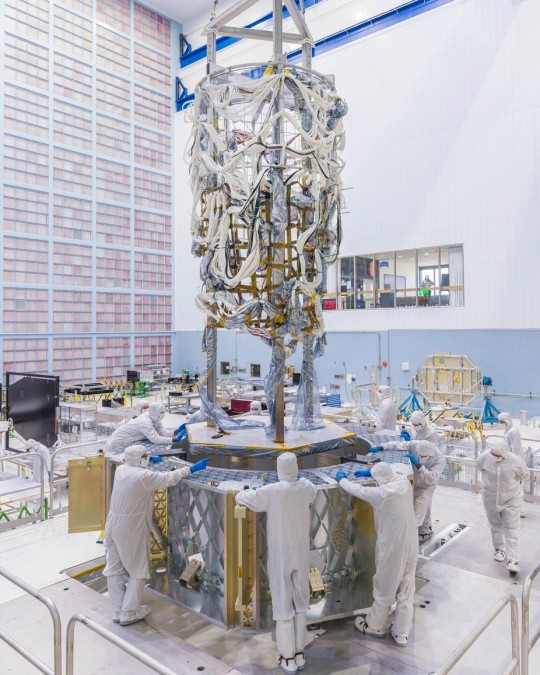
The Nancy Grace Roman Space Telescope’s flight harness is transferred from the mock-up structure to the spacecraft flight structure.
Your Body is Wired Like a NASA Space Telescope. Sort Of.
If our Nancy Grace Roman Space Telescope were alive, its nervous system would be the intricate wiring, or “harness,” that helps different parts of the observatory communicate with one another. Just like the human body sends information through nerves to function, Roman will send commands through this special harness to help achieve its mission: answering longstanding questions about dark energy, dark matter, and exoplanets, among other mind-bending cosmic queries.
Roman’s harness weighs around 1,000 pounds and is made of about 32,000 wires and 900 connectors. If those parts were laid out end-to-end, they would be 45 miles long from start to finish. Coincidentally, the human body’s nerves would span the same distance if lined up. That’s far enough to reach nearly three-fourths of the way to space, twice as far as a marathon, or eight times taller than Mount Everest!
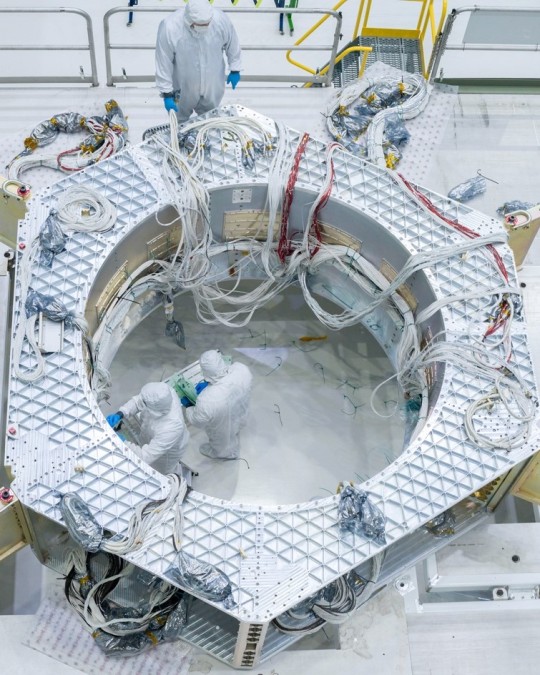
An aerial view of the harness technicians working to secure Roman’s harness to the spacecraft flight structure.
Over a span of two years, 11 technicians spent time at the workbench and perched on ladders, cutting wire to length, carefully cleaning each component, and repeatedly connecting everything together.
Space is usually freezing cold, but spacecraft that are in direct sunlight can get incredibly hot. Roman’s harness went through the Space Environment Simulator – a massive thermal vacuum chamber – to expose the components to the temperatures they’ll experience in space. Technicians “baked” vapors out of the harness to make sure they won’t cause problems later in orbit.
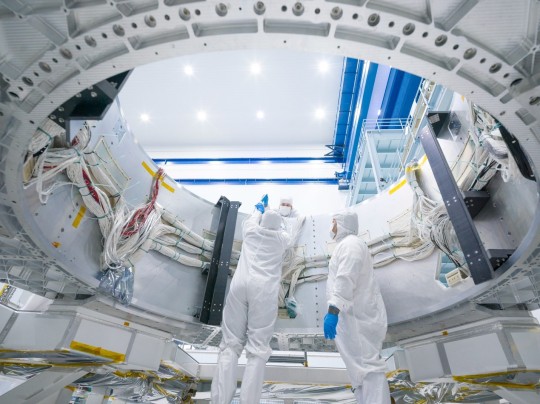
Technicians work to secure Roman’s harness to the interior of the spacecraft flight structure. They are standing in the portion of the spacecraft bus where the propellant tanks will be mounted.
The next step is for engineers to weave the harness through the flight structure in Goddard’s big clean room, a space almost perfectly free of dust and other particles. This process will be ongoing until most of the spacecraft components are assembled. The Roman Space Telescope is set to launch by May 2027.
Learn more about the exciting science this mission will investigate on X and Facebook.
Make sure to follow us on Tumblr for your regular dose of space!
4K notes
·
View notes
Text
Black holes
A black hole is a region of spacetime exhibiting such strong gravitational effects that nothing—not even particles and electromagnetic radiation such as light—can escape from inside it. The theory of general relativity predicts that a sufficiently compact mass can deform spacetime to form a black hole. The boundary of the region from which no escape is possible is called the event horizon. Although the event horizon has an enormous effect on the fate and circumstances of an object crossing it, no locally detectable features appear to be observed. In many ways a black hole acts like an ideal black body, as it reflects no light.
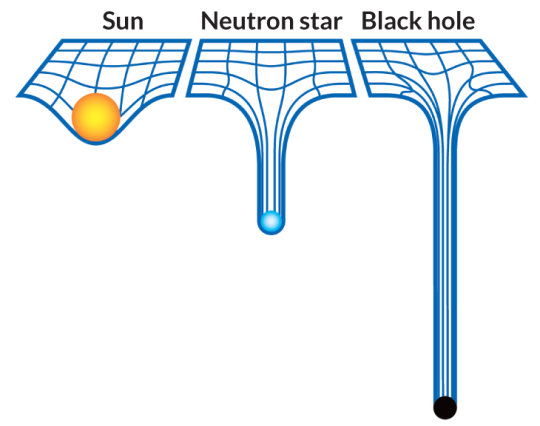
The idea of a body so massive that even light could not escape was briefly proposed by astronomical pioneer and English clergyman John Michell in a letter published in November 1784. Michell’s simplistic calculations assumed that such a body might have the same density as the Sun, and concluded that such a body would form when a star’s diameter exceeds the Sun’s by a factor of 500, and the surface escape velocity exceeds the usual speed of light.
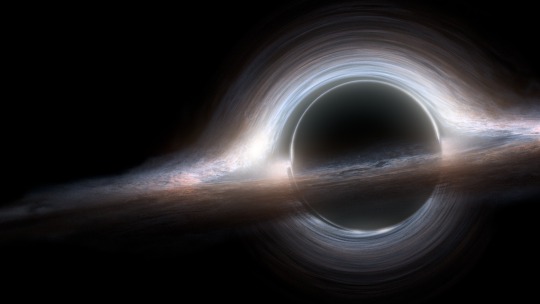
At the center of a black hole, as described by general relativity, lies a gravitational singularity, a region where the spacetime curvature becomes infinite. For a non-rotating black hole, this region takes the shape of a single point and for a rotating black hole, it is smeared out to form a ring singularity that lies in the plane of rotation. In both cases, the singular region has zero volume. It can also be shown that the singular region contains all the mass of the black hole solution. The singular region can thus be thought of as having infinite density.

How Do Black Holes Form?
Scientists think the smallest black holes formed when the universe began.
Stellar black holes are made when the center of a very big star falls in upon itself, or collapses. When this happens, it causes a supernova. A supernova is an exploding star that blasts part of the star into space.

Scientists think supermassive black holes were made at the same time as the galaxy they are in.
Supermassive black holes, which can have a mass equivalent to billions of suns, likely exist in the centers of most galaxies, including our own galaxy, the Milky Way. We don’t know exactly how supermassive black holes form, but it’s likely that they’re a byproduct of galaxy formation. Because of their location in the centers of galaxies, close to many tightly packed stars and gas clouds, supermassive black holes continue to grow on a steady diet of matter.

If Black Holes Are “Black,” How Do Scientists Know They Are There?
A black hole can not be seen because strong gravity pulls all of the light into the middle of the black hole. But scientists can see how the strong gravity affects the stars and gas around the black hole.
Scientists can study stars to find out if they are flying around, or orbiting, a black hole.

When a black hole and a star are close together, high-energy light is made. This kind of light can not be seen with human eyes. Scientists use satellites and telescopes in space to see the high-energy light.
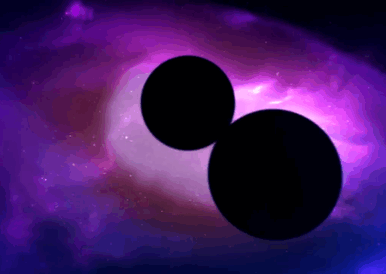
On 11 February 2016, the LIGO collaboration announced the first observation of gravitational waves; because these waves were generated from a black hole merger it was the first ever direct detection of a binary black hole merger. On 15 June 2016, a second detection of a gravitational wave event from colliding black holes was announced.
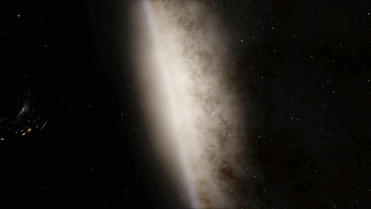
Simulation of gravitational lensing by a black hole, which distorts the image of a galaxy in the background
Animated simulation of gravitational lensing caused by a black hole going past a background galaxy. A secondary image of the galaxy can be seen within the black hole Einstein ring on the opposite direction of that of the galaxy. The secondary image grows (remaining within the Einstein ring) as the primary image approaches the black hole. The surface brightness of the two images remains constant, but their angular size varies, hence producing an amplification of the galaxy luminosity as seen from a distant observer. The maximum amplification occurs when the background galaxy (or in the present case a bright part of it) is exactly behind the black hole.
Could a Black Hole Destroy Earth?
Black holes do not go around in space eating stars, moons and planets. Earth will not fall into a black hole because no black hole is close enough to the solar system for Earth to do that.

Even if a black hole the same mass as the sun were to take the place of the sun, Earth still would not fall in. The black hole would have the same gravity as the sun. Earth and the other planets would orbit the black hole as they orbit the sun now.
The sun will never turn into a black hole. The sun is not a big enough star to make a black hole.
More posts about black holes
Source 1, 2 & 3
8K notes
·
View notes
Text
1 note
·
View note
Text

The Lambda Orionis Ring surrounding the star Meissa (λ Orionis) // Göran Nilsson
The name Meissa comes from the Arabic phrase "al-maisan" meaning the shining one.
42 notes
·
View notes
Text
Double stars are two stars that appear close together in the sky. They might be physically related or they might only appear to lie together along our line of sight. Double stars that aren’t gravitationally bound systems – but are only located near one another along our line of sight – are optical doubles. Double stars that are gravitationally bound and orbit a common center of mass are true binary star systems. Unlike our sun, scientists believe that most stars in our Milky Way galaxy orbit the galactic center in binary pairs. In fact, some estimates suggest that up to 85% of stars might reside in binary systems.
1 note
·
View note
Text
The 'silent' X chromosome within female brains may not be so silent after all. A new study has found evidence in both mice and humans that as we age, 'sleeping' X chromosomes can be 'awakened' in brain cells critical to learning and memory. The overlooked influence of this genetic library could be a key reason why females live longer than males and exhibit slower cognitive aging.
Continue Reading.
146 notes
·
View notes
Text
When spiders spin their webs, they use their hind legs to pull silk threads from their spinnerets. This pulling action doesn't just help the spider release the silk, it's also a crucial step in strengthening the silk fibers for a more durable web.
In a new study, Northwestern University researchers have discovered why the role of stretching is so important. By simulating spider silk in a computational model, the team discovered the stretching process aligns the protein chains within the fibers and increases the number of bonds between those chains. Both factors lead to stronger, tougher fibers.
Continue Reading.
147 notes
·
View notes
Text
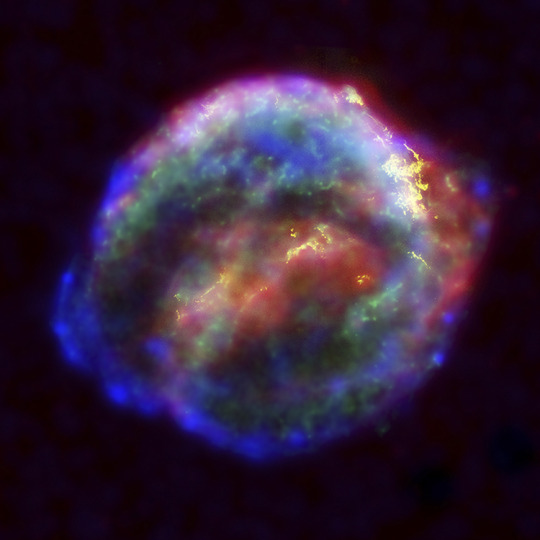

The Kepler supernova remnant is the debris from a detonated star that is located about 20,000 light years away from Earth in our Milky Way galaxy. In 1604 early astronomers, including Johannes Kepler who became the object’s namesake, saw the supernova explosion that destroyed the star. We now know that Kepler’s supernova remnant is the aftermath of a so-called Type Ia supernova, where a small dense star, known as a white dwarf, exceeds a critical mass limit after interacting with a companion star and undergoes a thermonuclear explosion that shatters the white dwarf and launches its remains outward. --- The remnant, called W49B, is about a thousand years old, as seen from Earth, and is at a distance about 26,000 light years away. The supernova explosions that destroy massive stars are generally symmetrical, with the stellar material blasting away more or less evenly in all directions. However, in the W49B supernova, material near the poles of the doomed rotating star was ejected at a much higher speed than material emanating from its equator. Jets shooting away from the star’s poles mainly shaped the supernova explosion and its aftermath.
Source: NASA
9 notes
·
View notes
Text
Researchers have revealed the regulatory mechanism of a specific protein that plays a key role in balancing the immune response triggered by viral infections in mammal cells. These findings could help drive the development of antiviral therapies and nucleic acid medicines to treat genetic disorders. The research is published in the journal Nucleic Acids Research. For cells to protect themselves from viral infections, a series of immune responses typically occur, including programmed cell death called apoptosis and interferon signaling. While apoptosis is a normal process, that occurs with or without the presence of viral molecules, following a cascade of steps to end with the death of a cell—which might not sound advantageous to the host—it can help prevent the reproduction of abnormal cells, including those infected by viruses, and eliminate them from the body.
Continue Reading.
62 notes
·
View notes
Text
We need two ingredients for life to start on a planet: dry land and (fresh) water. Strictly, the water doesn't have to be fresh, but fresh water can only occur on dry land. Only with those two conditions met can you convert the building blocks of life, amino acids and nucleic acids into tangible bacterial life that heralds the start of the evolutionary cycle. The oldest life on Earth left in our fragmented rock record is 3.5 billion years old, with some chemical data showing it may even be as old as 3.8 billion years. Scientists have hypothesized life might be even older, but we have no records of that being the case. Our new study published in Nature Geoscience provides the first evidence of fresh water and dry land on Earth by 4 billion years ago. Knowing when the cradle of life—water and land—first appeared on Earth ultimately provides clues as to how we came to be.
Continue Reading.
132 notes
·
View notes
Note
Hello! First of all, thank you for the wonderful content! It's a real joy, and an enrichment, food for both the brain and the heart! I was wondering if through your treasures, you could find some writing notes/words/concepts/vocabulary relating to genetic engineering? Like...creating a virus, and a vaccine for it, modifying the virus so it has certain specific effects.... Thank you in advance!
Writing Notes: Virus & Vaccine
References How Viruses Work; Replication Cycle; Mutation, Variants, Strains, Genetically Engineering Viruses; Writing Tips; Creating your Fictional Virus & Vaccine
Virus - an infectious microbe consisting of a segment of nucleic acid (either DNA or RNA) surrounded by a protein coat.
It is a tiny lifeform that is a collection of genes inside a protective shell. Viruses can invade body cells where they multiply, causing illnesses.
It cannot replicate alone; instead, it must infect cells and use components of the host cell to make copies of itself. Often, a virus ends up killing the host cell in the process, causing damage to the host organism.
Well-known examples of viruses causing human disease include AIDS, COVID-19, measles and smallpox. Examples of viruses:

Viruses are even smaller than bacteria and can invade living cells—including bacteria. They may interfere with the host genes, and when they move from host to host, they may take host genes with them.
Bacteriophages (also known as phages)—viruses that infect and kill bacteria.

Size differential between virus and bacterium
Viruses are measured in nanometers (nm).
They lack the cellular structure of bacteria, being just particles of protein and genetic material.
How Viruses Work
Viruses use an organism’s cells to survive and reproduce.
They travel from one organism to another.
Viruses can make themselves into a particle called a virion.
This allows the virus to survive temporarily outside of a host organism. When it enters the host, it attaches to a cell. A virus then takes over the cell’s reproductive mechanisms for its own use and creates more virions.
The virions destroy the cell as they burst out of it to infect more cells.
Viral shedding - when an infected person releases the virus into the environment by coughing, speaking, touching a surface, or shedding skin.
Viruses also can be shed through blood, feces, or bodily fluids.
Virus Replication Cycle
While the replication cycle of viruses can vary from virus to virus, there is a general pattern that can be described, consisting of 5 steps:
Attachment – the virion attaches to the correct host cell.
Penetration or Viral Entry – the virus or viral nucleic acid gains entrance into the cell.
Synthesis – the viral proteins and nucleic acid copies are manufactured by the cells’ machinery.
Assembly – viruses are produced from the viral components.
Release – newly formed virions are released from the cell.
Mutations, Variants, and Strains
Not all mutations cause variants and strains. Below are definitions that explain how mutations, variants, and strains differ.
Mutation - errors in the replication of the virus’s genetic code; can be beneficial to the virus, deleterious to the virus, or neutral
Variants - viruses with these mutations are called variants; the Delta and Omicron variants are examples of coronavirus mutations that cause different symptoms from the original infection
Strains - variants that have different physical properties are called strains; these strains may have different behaviors or mechanisms for infection or reproduction
Genetically Engineering Viruses
Using reverse genetics, the sequence of a viral genome can be identified, including that of its different strains and variants.
This enables scientists to identify sequences of the virus that enable it to bind to a receptor, as well as those regions that cause it to be so virulent.
Vaccine - a special preparation of substances that stimulate an immune response, used for inoculation
Vaccines & Fighting Viruses with Viruses
Common pathogenic viruses can be genetically modified to make them less pathogenic, such that their virulent properties are diminished but can still be recognized by the immune system to produce a robust immune response against. They are described as live attenuated.
This is the basis of many successful vaccines and is a better alternative than traditional vaccine development which typically includes heat-mediated disabling of viruses that tend to be poorer in terms of immunogenicity.
Viruses can also be genetically modified to ‘fight viruses’ by boosting immune cells to make more effective antibodies, especially where vaccines fail. Where vaccines fail, it is often due to the impaired antibody production by B-cells, even though antibodies can be raised against such viruses – including HIV, EBV, RSV & cold-viruses.
Related Articles: Modified virus used to kill cancer cells ⚜ Genetic Engineering ⚜ Engineering Bacterial Viruses ⚜ Benefits of Viruses
A Few Writing Tips
As more writers look to incorporate infectious diseases into their work, there are quite a few things writers should keep in mind:
Don’t anthropomorphize. Really easy to do, but scientifically wrong. Viruses don’t want to kill you; bacteria don’t want to infect you; parasites don’t want to make your blood curdle. None of these things are big enough to be sentient to want to do anything. They just do it (or don’t do it).
Personal protective equipment. This includes wearing gloves, lab coats, safety glasses, and tying your hair back if it’s long. It is the same as Edna Mode’s “no capes.” Flowing hair looks cool all the way to the explosive ball of flames that engulfs someone’s head.
Viruses are small. You can’t see viruses down a normal microscope—they need a special microscope called an electron microscope. These are highly specialized and take a long time to make the preparations to be able to see the virus. Normally viruses are detected by inference—measuring part of them using an assay that can amplify tiny amounts of material, for example PCR.
Viruses don’t really cause zombie apocalypses.
Vaccines work. But they take time. The best vaccine in the world will still only prevent infections two weeks after it is given. Drugs are quicker, but still take some time. But the good news is an infection is not going to kill you (or turn you into a zombie) quickly, so they both have time to work.
Scientists use viruses as a vector to introduce healthy genes into a patient’s cells:
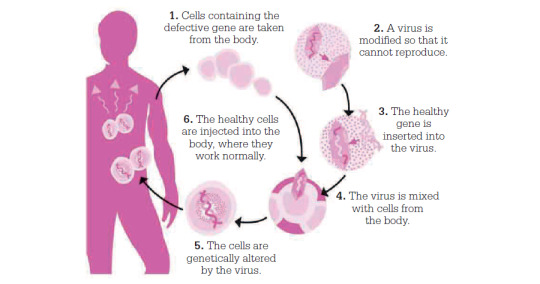
Your Fictional Virus & Vaccine
When creating your own fictional virus, research further on the topic and consider choosing a specific one as your basis/inspiration.
Here's one resource. For some of them, you'll need a subscription to access, but those that are available give you a good overview of the virus, as well as treatment options.
You can do the same for creating your fictional vaccine:
Here's one resource. And here's one on vaccine developments.
Sources: 1 2 3 4 5 6 7 8 9 10 11 12 13 ⚜ Writing Notes & References
Lastly, here's an interesting article on how science fiction can be a valuable tool to communicate widely around pandemic, whilst also acting as a creative space in which to anticipate how we may handle similar future events.
Thanks so much for your kind words, you're so lovely! Hope this helps with your writing. Would love to read your work if it does :)
131 notes
·
View notes
Text

The cytosine looks like an introvert waiting for the ribofuranose to come pick it up from a party they originally thought they could handle
5 notes
·
View notes





